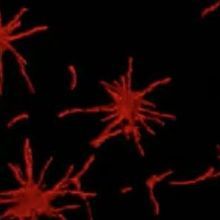 A time-lapse laser-scanning confocal microscopy video depicts Aspergillus fumigatus growth on media, imaged every 20 minutes for 20 hours.
A time-lapse laser-scanning confocal microscopy video depicts Aspergillus fumigatus growth on media, imaged every 20 minutes for 20 hours.
BRENDAN SNARR, RESEARCH INSTITUTE OF THE MCGILL UNIVERSITY HEALTH CENTRE
A. fumigatus rapidly develops biofilms, which protect the microbe from drugs and its host's immune defenses, according to a news release. Scientists were able to disrupt A. fumigatus’s biofilm-forming abilities with polysaccharide-degrading enzymes derived from the microbes themselves.
"We were able to use the microbe's own tools against them to attack and destroy the sugar molecules that hold the biofilm together," says Don Sheppard, director of the Division of Infectious Diseases at the McGill University Health Centre and a lead author on the study, in the release.
See B.D. Snarr et al., “Microbial glycoside hydrolases as antibiofilm agents with cross-kingdom activity,” BioRxiv, doi:10.1073/pnas.1702798114, 2017.
Interested in reading more?




